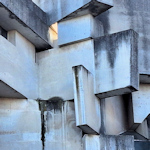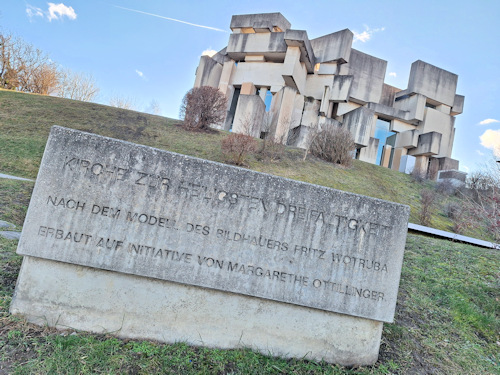
You’ll have to look very hard to find Vienna’s 23rd district in most tourist brochures. But like all good city suburbs, it has its surprises and highlights. Including one of the most remarkable pieces of church architecture in Europe: the Wotrubakirche.
- Built from 152 concrete blocks of different sizes
- Completed in 1976
- Designed by sculptor Fritz Wotruba
- See also:
A church in concrete

(No one block is the same)
As you walk out from Vienna toward the wooded Georgenberg hill, you find yourself confronted by an unexpected sight.
A building in the brutalist style, constructed out of 152 assorted concrete blocks, each plain and seemingly misaligned…as if some child of a Titan had a moment of creative inspiration.
When the sun lies behind the Wotrubakirche, the effect is almost of a solstice at Stonehenge. And that connection is perhaps not entirely undeserving, even if some five thousand years separate the spirituality of both locations.
Asked to guess the building’s purpose and most might go for a museum of contemporary art. This is, however, the Church of the Holy Trinity: home to a catholic congregation (and a friendly, active church community, if the noticeboards within are anything to go by).
The more colloquial designation as the Wotrubakirche or Wotruba church comes from the name of the man who designed the building: Fritz Wotruba (1907-1975), an Austrian sculptor of international renown whose works can fetch six-figure prices at auction.
The building looks out across southwest Vienna, a part of the city rarely troubled by tourist buses.

(The church sign)
Wotruba turned his attention to ecclesiastic architecture at the initiative of Margarete Ottillinger (the square in front of the church is named after her) with the implementation following under the aegis of architect Fritz Mayr.
Ottillinger apparently wanted to make a statement and create a bulwark in times of diminishing faith. Wotruba’s intention was more secular.
Completed in 1976, the apparent randomness of the design actually coalesces into a unit. Perhaps a metaphor for a diverse community. The message gains added resonance when you know the same site once hosted Nazi barracks.
The block design continues inside, creating a pleasingly roomy and unexpectedly bright interior around a central altar and low-lying pulpit that must contribute to an intimate feeling at gatherings.
Given the nature of the construction material, the building retains an unadorned rawness to it, almost the antithesis of the Baroque decoration common in Vienna’s old town churches. Yet it remains atmospheric; a place of hushed whispers, also because of the extraordinary echo effect.
Thanks to its unique design, the church has made quite a name for itself in architectural circles. Especially among those interested in brutalist architectural gems. So you probably won’t be alone on your visit.
Tickets & visitor tips
There is no charge to visit this working church, but check the website (see below) as opening hours are largely limited to weekends.
How to get to the Wotrubakirche
Ah. Vienna’s hop on hop off buses do not stop here. And you’re going to have to walk a bit if on public transport.
The 60A bus does drop you “closest” at the stops Kaserngasse and Lindauergasse.
We actually caught the 60 tram to Maurer Lange Gasse, which is further away, but trams are trams, and you can catch the 60 from Hietzing station on the U4 subway line.
Address: Ottillingerplatz 1, 1230 Vienna | Website